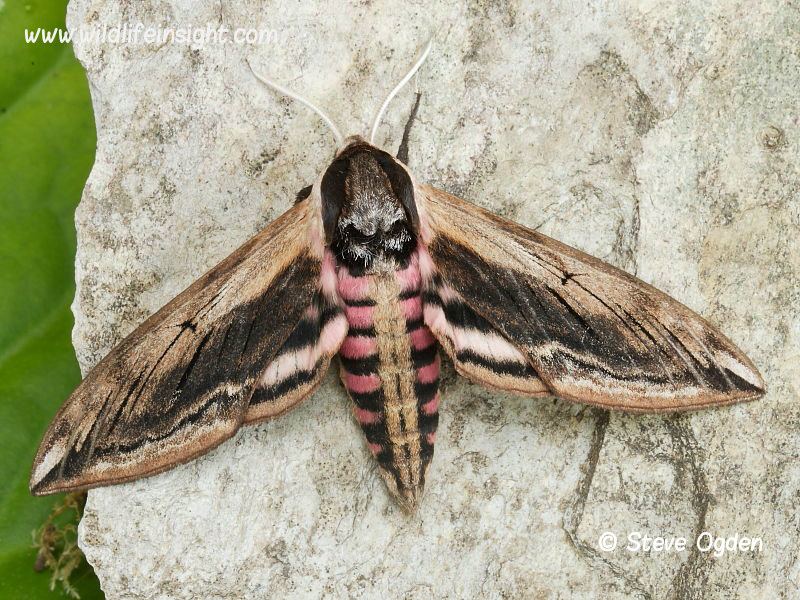Privet Hawkmoth, Sphinx ligustri
The Privet Hawkmoth, Sphinx ligustri, is a member of the large Sphingidae Hawkmoth family and a species commonly found in the southern half of the UK and much of Europe.
It has a wingspan of c 120 mm, the widest wingspan of any resident moth in the British Isles.
It flies in a single generation from June to July in a wide range of habitats when it is commonly attracted to light in gardens,
At rest the wings are held tightly to its side, when it can occasionally be found on trees, walls and fences during the day.
When disturbed it opens its forewings to reveal a boldly, red and black striped abdomen.
Other common European Hawkmoths include –
Migrants Hawkmoths to northern Europe from Southern Europe, The Middle East and Africa include –
Privet Hawkmoth caterpillar, Sphinx ligustri
The Privet Hawkmoth caterpillar, Sphinx ligustri grows to 85 mm in length, is bright green with white, purple edged, diagonal stripes.
The mainly black tail horn and black facial collar are other features that can help with identification.
Unlike many Hawkmoth caterpillars the larvae don’t have different coloured forms.
Other Hawkmoth caterpillars can be seen in the British caterpillar gallery and Hawkmoth gallery
Larval foodplants of the Privet Hahkmoth
In the British Isles the caterpillars have been recorded feeding on a wide variety of foodplants but most commonly on Wild and Garden Privet and Ash, particularly on fresh lower growth and saplings.
Lilac, Snowberry and Olive trees are some of the other less common larval foodplants.
The Ash leaves featured show recently hatched larvae evenly spread out, one to each leaf.
If young larvae meet they will fight to the death.
Life cycle of the Privet Hawkmoth
Privet Hawkmoth prepupating caterpillar, Sphinx ligustri
Prepupating Privet Hawkmoth caterpillars are reddish brown dorsally.
They are frequently sighted on the ground searching for a place to pupate in the soil.
Privet Hawkmoth pupa, Sphinx ligustri
The pupae overwinter, with the adult moths emerging in early summer.
Other commonly sighted Hawkmoth caterpillars in the British Isles include the Poplar Hawkmoth, Eyed Hawkmoth and Lime Hawkmoth.
The caterpillars of Oleander Hawkmoth caterpillar, Death’s Head Hawkmoth, Convolvulous Hawkmoths and Striped Hawkmoth are other species only occasionally recorded in the UK but commonly recorded in warmer parts of the world.
An interesting late in the year sighting was made by Barry Ofield in October 2015 of two final instar Privet Hawkmoth caterpillars in a Snowberry hedge in his Cornish garden.
Despite being in their final instar and fully developed they were only 65 mm long. Barry reared them through and they pupated successfully before overwintering as pupae.
Both moths emerged the following June and were also very small as can be seen in the photo when compared to a set specimen reared by Barry in 1960.
Possibly this had been a second brood that had failed to develop properly due to falling temperatures. Nevertheless, the two emerging Privet Hawkmoths were perfect specimens in all but size. Many thanks to Barry for his observations.
Recommended Sphingidae (Hawkmoth, Sphinx, Hornworm) reference books
The Hawk Moths of North America – James. P. Tuttle.
Hawkmoths of the Western Palearctic – Pittaway.
The Colour Identification Guide to Caterpillars of the British Isles – Jim Porter.
Caterpillars of Eastern North America – David. L Wagner.
Field Guide to the Moths of Great Britain and Ireland – Waring, Townsend and Lewington.
Moths of the British Isles – Bernard Skinnner.
